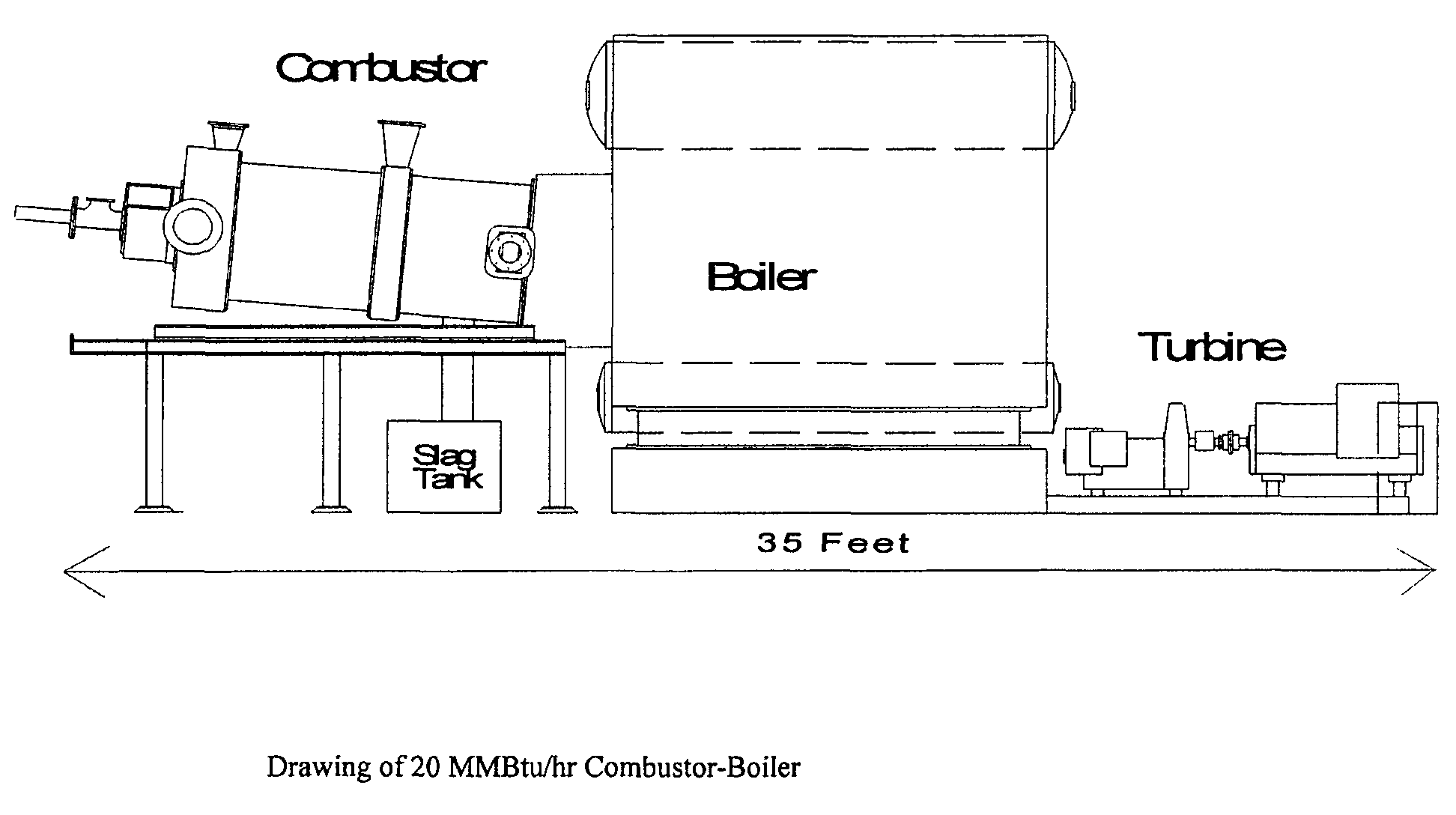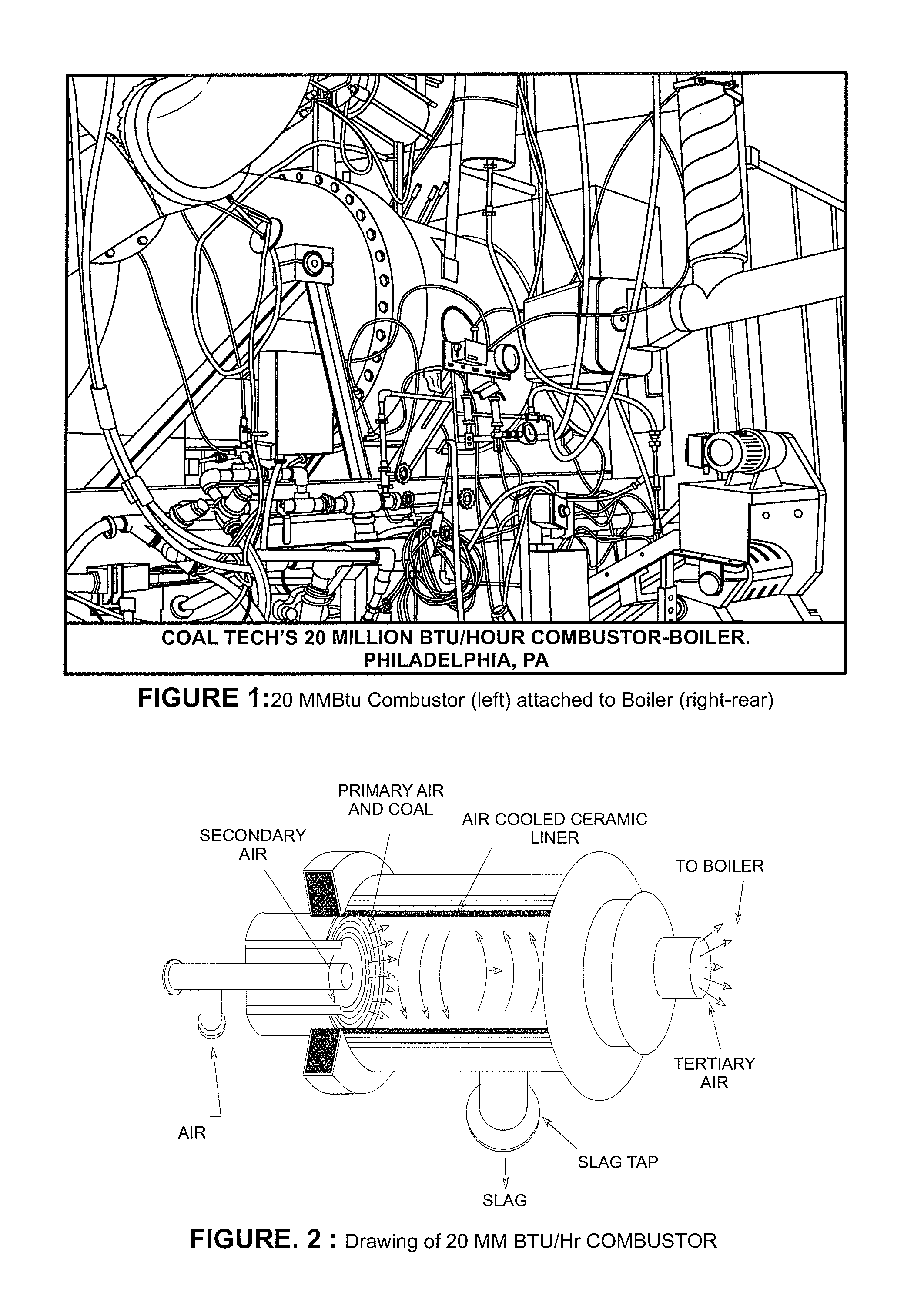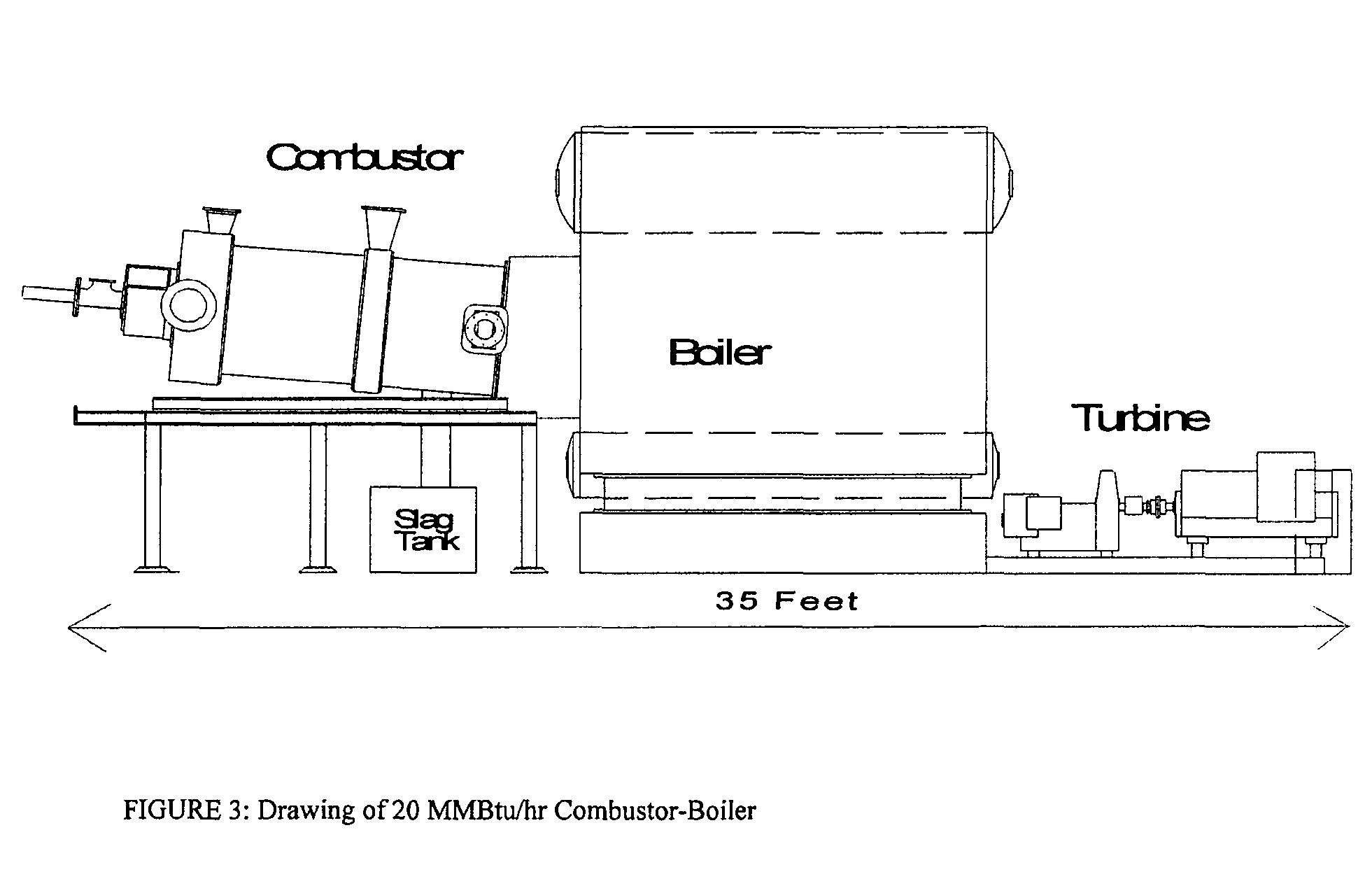(H) Convert CO2 removal and sequestration costs into profit, as opposed to other CO, processes that are costly, result in only partial CO2 sequestration, or as in major multi-billion dollar projects that use CO2 sequestration for enhanced
oil field recovery which actually sharply increases CO2 when the recovered oil is burned.
a)
NOx reduction: Over 90%
NOx reduction from an uncontrolled 1 lb / MMBtu to less than 0.1 lb / MMBtu were demonstrated by fuel rich combustion in this
combustor, followed by further NOx reductions in the combustor's gas exhaust by means of Selective Non-Catalytic Reduction (SNCR) with
urea or
ammonia, and with or without reburn firing of the post-combustion gases inside the boiler with either pulverized coal,
natural gas, or
biomass as the reburn fuel. Both the SNCR and Reburn NOx processes were implemented in a nominal 2000° F. post-combustion zone in the
boiler furnace, as disclosed in U.S. Pat. No. 7,553,463, U.S. Pat. No. 7,435,400, U.S. Pat. No. 7,247,285, U.S. Pat. No. 6,722,295, U.S. Pat. No. 6,453,830, U.S. Pat. No. 6,048,510, U.S. Pat. No. 4,765,258, and U.S. Pat. No. 4,624,191. The capital costs for NOx reduction to less than 0.1 lb / MMBtu are in the range of a few $ / kW and can be implemented on almost any boiler. As disclosed in the first two patents in this
list, this SNCR process can duplicate the performance of
Selective Catalytic Reduction (SCR) systems whose capital costs are well in excess of $100 / kW compared with under $10 / kW with the present SNCR and Reburn processes.
b) SO2 reduction: SO2 reduction is achieved by injection of limestone into the combustor followed by co-injection of
calcium hydroxide mixed with the
urea or
ammonia used in the SNCR NOx process. Most of the above-cited NOx patents make provision for SO2 reduction. The most recent U.S. Pat. No. 7,553,463 discloses means for achieving SO2 reductions that can duplicate the near zero emissions achievable with post-combustion
Flue Gas Desulfurization (FGD) to less than 0.1 lb / MMBtu). FGD capital costs are in the $400 / kW range, which is so costly that it has been installed almost exclusively on large (over 300 MW) coal power boilers. In sharp contrast, the capital costs for SO2 reduction with Zauderer's patents are in the same several $ / kW range as the NOx processes, a cost that is further reduced by the use of the same components as the SNCR NOx process. One novel feature is that part of the SO2 reduction process takes place inside the air-cooled combustor where CaSO4 particles are formed by reaction of CaO with SO2, and the particles
impact and dissolve in the
liquid slag layer that lines the inside of the combustor. The slag is drained through a slag tap and quenched in a water tank to form cementitious slag, with the
sulfur compound trapped in the chemically
inert slag.
c) Removal of Trace Metals in
Coal Ash: A feature needed for safe permanent CO2 sequestration, especially for sequestration in underground
saline formations, is
trapping the volatile trace metals in coal ash in the slag lining the inside walls of the air cooled combustor and removing the slag within 3 minutes to prevent re-evolution of these metals into the combustion gases, as detailed in U.S. Pat. No. 7,247,285. The metals include
arsenic (As),
barium (Ba),
cadmium (Cd), lead (Pb), mercury (Hg),
selenium (Se), and
zinc (Zn) that are released during coal combustion. An extremely important result disclosed in U.S. Pat. No. 7,553,463 is that in Bituminous coals most of the mercury is concentrated in the
mineral matter, namely the ash, and its concentration is related to the
arsenic concentration in the ash (FIG. 4). Therefore, it can be retained in the slag, and does not require the use of
activated carbon injection in the combustion gas exhaust, as is the case in sub-bituminous and lignite coals, which account for the other one-half of U.S. coal use. The slag layer flow rate on the combustor walls is controlled with limestone injection, which lowers the slag
viscosity, and assures rapid
liquid slag drainage without volatile
metal re-evolution. SO2 that reacts with calcined limestone inside the combustor is also trapped in the slag and removed by water
quenching. This quenched slag has similar cementitious properties as
Ground Granulated Blast Furnace Slag (GGBFS), whose
mechanical strength is greater than
Portland cement, and therefore its market value is almost double that of
Portland cement. The high market value of this slag is the major factor in making this combustor so economically attractive for the CO2 sequestration and offsets.
d) Dioxins and Furans. U.S. Pat. No. 7,247,285 disclosed methods to eliminate dioxins and furans, which are highly toxic trace compounds that are generally released during
incineration of
Municipal Solid Waste (MSW), and to a much lesser extent in combustion of fossil fuels, mainly coal. This patent disclosed that dioxins and furans can be controlled in the air-cooled slagging combustor and in the
post combustion region of boilers and furnaces. To use MSW in the combustors it must first be processed into
Refuse Derived Fuel (
RDF), which looks like fuzz collected in vacuuming a carpet, by removing the
inert matter in MSW.
RDF also contains plastic chips in the mm size range. In tests conducted by the present inventor in the 20 MMBtu / hr air-cooled combustor it was observed that co-firing of RDF with 80% to 90% pulverized coal produced the best combustion results because the RDF dispersion in the combustor is not completely uniform.
On the other hand, MSW furnaces use
mass burning on a traveling grate, which results in non-uniform combustion.
This equals to only a 47% annual
capacity factor, a very poor number considering that coal power plants operate from 60s % to 80% annual capacity factors.
According to a March 2009 MIT Report, coal plants rated at below 300 MW are too small to justify the super-critical technology.
It is very costly to ship more than a few tens of miles to an incinerator.
However, this WTE
plant efficiency and use compares very poorly with an average of 10,000 Btu / kWh for coal power plants in the 50 MW to several 100s MW range that operate between the 60% to 80% capacity range annually.
If this cost cannot be passed on to the County MSW suppliers, the WTE
plant would incur an added cost to the
plant's presumed average 113,960 MWH an annual CO2 emission of 433,048 tons.
Of course other constraints may enter into these calculations, such as hazardous trace metals leaching into
groundwater.
Also, even with recycling, estimates are that plastics account for 41% of the waste and this is not renewable.
However, the major argument against WTE plants is their extremely low efficiency and poor capacity utilization.
For gas fired gas
turbine power plants, with the minimal CO2 concentration of about 3% by volume, the amine process is cost prohibitive.
 Login to View More
Login to View More 


